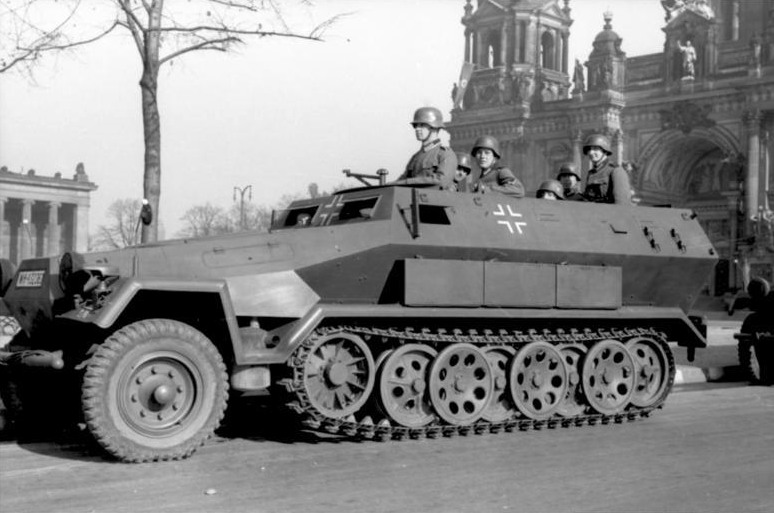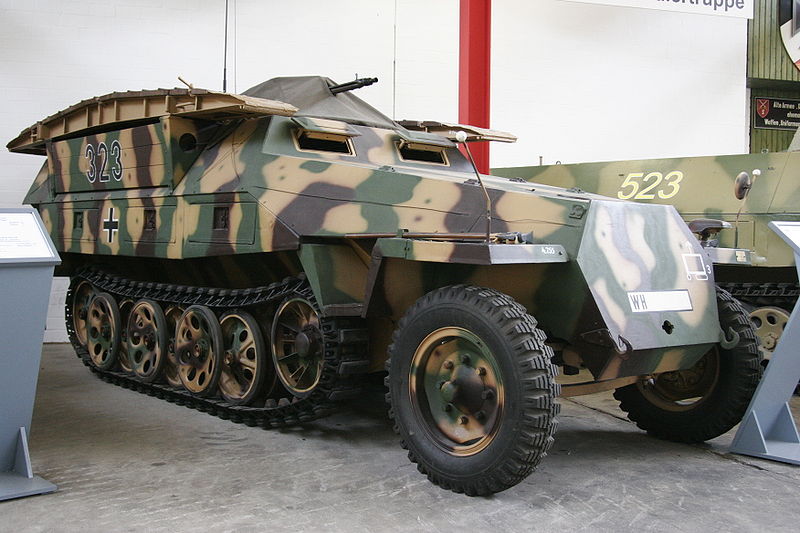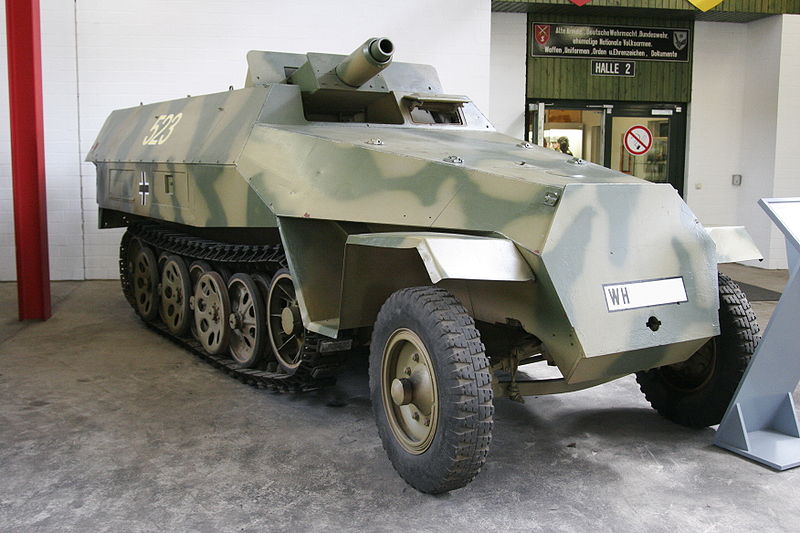Genesis of the Sonderkraftfahrzeug 251
This vehicle was a familiar sight, widely associated with the German infantry during all of World War Two. It began simply as an armored version of the Sd.Kfz.11 half-tracked artillery tractor. The half-track was one of the several solutions given to the problem of low off-road capabilities of trucks and associated “special purpose vehicles” (Sonderkraftfahrzeug). The Sd.Kfz.11 was designed in 1938 by Hanomag and was the prime mover for the 105 mm (4.13 in) LeFH howitzer and 37 mm (1.46 in) Flak 43, and 9000 units were built until 1945. This company was the natural choice to fulfill the next Waffenamt specification, which requested an armored vehicle capable of carrying a platoon of Panzergrenadiers and their equipment in order to keep up with the Panzer Divisions. Each German mechanized infantry corps was to be equipped with a hundred of these. The protection given had to be sufficient against small arms fire and artillery shrapnel, and armament should comprise two MG 34 machine-guns for defense and direct support. In German nomenclature it was classed as a Mittlere Schützenpanzerwagen (“Medium Assault Armored Vehicle”).
Design of the Hanomag half-track
Because the Sd.Kfz.251 was produced by the same manufacturer as the Sd.Kfz.11, the natural choice was to use the HL kl.5 chassis as a base on which a stronger framework, supporting the armored panels, was constructed. After a few sketches, the sloped armor that characterized the type was taken from the previous 7.5 cm Selbstfahrlafette L40 prototype made by Hansa-Lloyd (1937). This was a risky choice in terms of efficient storage and production ease, but the idea behind was straightforward. The slope meant that any bullet or shrapnel had to travel through more of the plate, while keeping the weight low. The armor protected the entire length of the engine, radiator, driver and the open top rear compartment. It was 14.5 mm (0.57 in) thick, with a 14° slope at the nose, 10 mm (0.39 in)/80° for the glacis (engine cover), 8 mm (0.31 in)/35° for the side and rear panels and only 6 mm (0.24 in) for the flat bottom.
The hull was entirely welded, with prefabricated sections. The open-top configuration allowed a greater awareness of the situation and allowed a better angle and arc of fire for the machine-guns. The body was composed of two main sections, the front cowling and the rear open-top “passenger compartment”. These two sections were made of steel plates welded and riveted to the base chassis. They were joined together by riveting, the reinforcements being located behind the driver’s compartment. This provision, associated with the initial strength of the chassis of the vehicle, provided exceptional rigidity.
The engine was the same Maybach TUKRM HL 42 (4.17L) as that of the Sd.Kfz.11. This was a petrol 6 cylinder four-stroke watercooled engine with magnetic ignition, providing 100 hp@2800 rpm. It provided a 12.8 hp/tonne power-to-weight ratio, giving an average 52 km/h (32 mph) on roads or very flat terrain, and 21 km/h (13 mph) off-road. This was relatively fast for an armored half-track. Steering was done using the front axle, with a turning radius of 11 m. The tracks, of the Zgw 5001/280/140 or Zpw 5001/280/140 type, were relatively large and procured excellent grip, especially with the W 302 rubber tread pads. Each comprised 55 and 56 (left /right) links and were 7.7 and 7.84 m long. The Sd.Kfz.251 was one of the first armored vehicles to be equipped with interleaved wheels, just like the Kettenkrad.. This “slack track” lowered the ground pressure, but they proved problematic on highly muddy terrain, like during the Russian “Raspoutista”.
The hollow weight was 6.8 tons, 7 tons in battle order and 8.5 tons or more when fully loaded. It had a payload capacity of 1.5 tons and a towing capacity of 2.7 tons, which meant that the Pak 36 or a 20 mm (0.79 in) AA autocannon could be carried. Normal crew was 12, including the driver, platoon commander, and ten Panzergrenadiers and their equipment.
Production & evolution: The Ausf.A and B
The Ausf.A (Ausführung A or “A-version”) was the first of the Mittlerer Gepanzerter Mannschaftskraftwagen. It appeared in mid-1939 and was first allocated to the Panzergrenadiers attached to the 1st Panzer Division (stationed at Weimar, during the spring of 1939), the best equipped German unit at the outbreak of the Polish campaign. Production figure estimates for 1939 are only 232, and production was assumed by Hanomag in Hanover, Büssing-NAG of Berlin Oberschoeneweide, Weserhuette of Bad Oeynhause, Wumag of Goerlitz, and F. Schichau of Elbing.
The Ausf.B appeared in 1940and was similar in all aspects but the relocated radio antenna (from the step to the rear fighting compartment), and the removal of the rear vision sights, for production ease. By the end of 1940, only 337 more would be delivered. An estimated 500 took part in the French campaign.
The Ausf.C
The Ausf.C (late 1941) was also very similar, but introduced a new flat engine nose plate, 14.5 mm (0.57 in) thick, without an access trap, replaced by a simple hole for the manifold. Other minor mass-production simplifications included the rear access doors. Attention was also paid to the engine, with the removal of the front hood cooling grid and the lateral access traps, replaced by large open ventilation boxes, and the lower part of the hull was modified to increase the compartment draw. The rear muffler storage boxes were relocated to the rear, and the mufflers themselves were completely modified. The rearview mirror was relocated from the driver side vision slit to a lower position. The headlights were now fixed directly to the chassis and the bumpers removed and replaced by towing hooks. Production for 1941 is assumed to be 389 vehicles. However, an increase in production was urgently needed, but by 1942 these figures rose only to 424 and around 1200 for 1942. Unit cost was 22,560 DM.
The Ausf.D
This version was introduced in the spring of 1943 as a set of small changes in design for mass-production. The previous versions, also known as the “Alte” (around 4650 from June 1939 to September 1943) included the A, B and C, but the Ausf.D, also known as “Neue” was different, and 10,602 were built by Hanomag, MNH, Schichau Wumag, Weserhätte, Borgward, Evans+Pistor, Deutsche Werke and Büssing-NAG between 1943 and ’45. The modifications included many changes in production design. The number of armored panels was reduced from 19 to 9, permanent stowage boxes with padlocked access traps were added, replacing the former rear mufflers. Simple vision slits, simple flat engine hood panels with relocated air intakes under the hull, simplified reverse sloping rear end with flat door panels and many other minor modifications allowed the simplification of construction while offering the same protection, and it was far less labor-intensive. A feet of engineering required in times of increasing Allied bombings and exhausting metal supplies. However, the internal configuration was unchanged since the Ausf.C, and the FuG Spr Ger f radio was still in use. By this stage in the war, the Ausf.D was more and more required for ad hoc modifications and conversions due to a dramatic increase in the need of fire support platforms of all kind.
The “little brother”, Sd.Kfz.250
The Sd.Kfz.250 specifications were first issued by the Inspectorate for Motorized Troops (AHA/In 6) in 1939, as a light armored half-track for other purposed than transport or towing vehicles, to accompany the tanks in attack. Future tasks included reconnaissance, radio liaison, supply, mobile headquarter or artillery observation. It was produced by Demag, Adlerwerke, Büssing-NAG, MWC from 1941 to 1945 at an extent of 6630 vehicles, and was externally a shortened SdK/Fz 251, which led also to many fire support and special purpose variants. Büssing-NAG and Adler built the chassis, Saurer Werke of Vienna the engine and transmission, DEW Hannover and Steinmueller of Gummersbach the superstructure, Bismarckhuette of Upper Silesia the armour plating, hull assembly was done by Evens & Pistor of Helsa, equipment, supervision and delivery were assured by Demag AG of Wetter.
The Sd.Kfz.251 Hanomag in action
The Sd.Kfz.251 was seen as a real improvement for infantry mobility, and added weight to the doctrine of using motorized infantry to accompany the tanks. It was also a well-known propaganda tool in the newsreels, which led most of the Germans into thinking that the bulk of the German infantry was carried by these armored vehicles. But the reality could not be farther from the truth. Due to its cost and slow production, these vehicles were only allocated to some Panzergrenadier platoons, almost specialized elites within the infantry, and only attached to the best-equipped Panzerdivisions. By September 1939, only the 1st Panzerdivision was partially equipped with these vehicles. By the start of the Western campaign, in May 1940, perhaps five Panzerdivisions were also partially equipped. By then, the two types involved were the Sd.Kfz.251/1 mittlerer Schützenpanzerwagen, Gerät 901 for the Panzergrenadiers, and the Sd.Kfz.251/1 mittlerer Schützenpanzerwagen with no radio. Well used, this vehicle never encountered bad situations which could have been fatal due to its lack of armor. This was however a limitation later, with the use of some close-support versions, like the Sd.Kfz.251/10 equipped with the short-range Pak 36 37 mm (1.46 in) AT gun. Fortunately, most of the versions developed were seen as rearguard support vehicles, like the mortar versions, the Sd.Kfz.251/2 mittlerer Schützenpanzerwagen (Granatwerfer), Gerät 892, or the famous Sd.Kfz.251/1 mittlerer Schützenpanzerwagen (Wurfrahmen 40) used after 1944 with great effect for radio relaying, coordination, armored ambulances, and artillery observation.
The Sd.Kfz.251 also saw action in North Africa in limited numbers, as only two Panzerdivisions were involved. There was no real tropicalized version -only late modifications in the field. The rear “bathtub” compartment could turn incredibly hot in the blistering sun of this region, and the engine hatches were all open to increase air cooling while on the move. The bulk of the A,B,C saw action in the Balkans, in Greece, and in Russia by the summer of 1941. By then, most Panzerdivisions were equipped with this vehicle, at least partially. Less than a thousands were available at the same time for Operation Barbarossa. Production later increased, but, at the same time, more and more were converted for support and special purpose vehicles. In Russia, the local situation dictated many conversions for the engineers attached to the Panzerdivisions. In fact, if only 23 main versions were officially known by the Waffenamt, there have probably been countless modifications in the field, testified on photos showing vehicles using captured foreign guns, using non conventional antennae, or makeshift conversions as command and observation vehicles.
In Russia, the winter conditions meant that the engine could not always perform well or even start at all, and all the rubber parts had a tendency to crack and fall apart under the extreme cold. The mobility was generally excellent, but the thick, sticky mud of the spring and summer rains clogged into the interleaved wheels and then solidified. By the time of the introduction of the simplified Ausf.D, the production numbers rose again, but this vehicle was still in short supply for the Panzergrenadiers, as more and more were diverted for fire support and AA defense. The most successful in this way was the Schützenpanzerwagen (7.5 cm KwK37) or “Stummel”, used for artillery support, and the antitank 7.5 cm PaK 40 L/46 auf Mittlerer Schützenpanzerwagen, which replaced the ill-fated Sd.Kfz.251/10. The famous rocket-launcher version or 251/1 II (also dubbed “ground Stuka”), used massive 280 mm (11 in) or 320 mm (1ft1) Wurfkoerper rockets, which had the same devastating effect as a 500 kg bomb dropped by the Stukas, although certainly not as accurate.
The Sd.Kfz.251 variants
The Sd.Kfz.251/1 (II/III)
Although strangely classed as 251/1, these two late versions has nothing in common with the main version.
The Sd.Kfz.251/1 II mittlerer Schützenpanzerwagen mit Wurfrahmen, was a heavy rocket launcher platform (also dubbed “Stuka zum Fuss”), equipped with six massive 28cm Sprengranate (HE rounds) or 32cm Flammgranate (incendiary rounds), the latter using napalm. They were called Wurfrahmen 40, and had a range of 1.9 and 2.2 km, respectively. First ordered in late 1940, these Wurfkoerper rocket launching vehicles only appeared by 1943-44 in limited numbers.
The Sd.Kfz.251/1 III mittlerer Schützenpanzerwagen (IR) “Falke” were standard Ausf.D (mostly) vehicles specially equipped with infrared equipment for night operations in conjunction with the Sd.Kfz. 251/20 Uhu, accompanying IR Panther detachments. This version is also called 251/20 “Falke”.
The Sd.Kfz.251/2 Schützenpanzerwagen (Granatwerfer)
This was the standard motorized mortar version, used by the infantry. It carried a GrW34 81 mm (3.19 in) mortar with 66 rounds. The recoil bottom plate could be removed for offloaded use.
Sd.Kfz.251/3 – mittlere Kommandopanzerwagen (Funkpanzerwagen)
The main radio version, which was subdivided into five versions, each using upgraded radio combinations, like the FuG8 + FuG5 (I, II), FuG1 + FuG7 (III), FuG11 + FuG12 (IV – long range, with a telescopic 9 m mast, and a command subvariant), and the FuG11 for the fifth subversion.
Sd.Kfz.251/4 – Schützenpanzerwagen für Munition und Zubehör des leIG18
This version was strengthened for towing heavier guns, such as the 7.5 cm (2.95 in) leichtes Infanteriegeschütz 18, 50 mm (1.97 in) Pak 38, 75 mm (2.95 in) PaK 40, and 10.5 cm (4.13 in) leFH18 light field howitzer.
Sd.Kfz.251/5 – Schützenpanzerwagen für Pionierzug
The main assault engineer vehicle (Pionierzug), modified to carry a pair of light dismantlable assault bridges on top. Inflatables boats were carried in the side stowage boxes.
Sd.Kfz.251/6 – mittlere Funkpanzerwagen (Kommandopanzerwagen)
This early command and radio vehicle housed map boards, cipher and encoding machines in a rearranged compartment, based on Ausf.A/B versions.
Sd.Kfz.251/7 Pionierpanzerwagen
Another engineer assault vehicle fitted with bridge ramps and special fitting on the upper hull. The I and II sub-versions used different radios.
Sd.Kfz. 251/8 Krankenpanzerwagen
The armored ambulance version. Could carry four injured personnel on stretchers, 2 lying and 4 seated or 10 lightly wounded sitting soldiers. To help access, a folding step beneath the doors was also added. Most were converted from early A-B and C versions during the war. There was no armament and a large canvas or roof was used to cover the top. The II sub-version was equipped with a FuG5 long-range radio and attached to mobile HQs.
Sd.Kfz.251/9 – Schützenpanzerwagen (7.5 cm KwK 37 L/24) “Stummel”
The standard SPG variant, also called “kanonenwagen”, was equipped with a short-barrel 75 mm (2.95 in) howitzer, which used the same mounting as the StuG III. It was nicknamed “Stummel” (Stump), and committed in great numbers on the Eastern Front. First ordered in a March 1942 specification, Büssing-NAG delivered two prototypes in June, tested in Russia. A first batch of 150 vehicles was delivered during the following months, based on the Ausf.C. By late 1944, a major modification included a revised modular higher gun-mount with a coaxial MG 42 for close defense.
The latter also gave better protection, better depression and higher traverse (20° on each side). Normal traverse was 10 to 12° on each side, and a -5 +20° elevation. The gun provision was 52 rounds, but many were carried wherever it was possible, notably on the rifle racks and crammed in extra soft bags. Scissor binoculars and relocated a Fuspr.f 2 meter rod-antenna were also present. The Stummel was first introduced with the SS-Panzerregiment 4 “Der Führer”, 2nd SS Armored Division and, later, (after the Ausf.D came into service in 1944) in most armored reconnaissance units, and the paratrooper division “Hermann Göring”. Such vehicles could be carried inside the Me 323 “Gigant”.
Sd.Kfz.251/10 – Schützenpanzerwagen (3.7 cm PaK)
The standard early AT support version for the Panzergrenadiers, equipped with the 37 mm (1.46 in) Pak 36 gun, which had an effective range of about only 1200 m. Many photos show that the removable upper panels of the shield were discarded , as the crew was well protected inside the hull, and in order to fool observers, as it thus resembled the MG shield of the standard transport version.
Sd.Kfz.251/11 – Fernsprechpanzerwagen
A telephone cable-layer version, based on the Ausf.C. A large box-like laying apparatus with cable reels was housed in the rear compartment, with little room to spare for the operators. They were used to create a network in the occupied territories of Russia.
Artillery auxiliary vehicles
Sd.Kfz. 251/12 – Messtrupp und Gerätpanzerwagen : A visual survey vehicle, the main artillery observation version.
Sd.Kfz. 251/13/14 – Schallaufnahmepanzerwagen : Sound recording carrier variant.
Sd.Kfz. 251/15 – Lichtauswertepanzerwagen : Flash spotting carrier variant.
Sd.Kfz. 251/18 – Beobachtungspanzerwagen : Artillery independent observation variant, which comprised three radio sub-versions.
Sd.Kfz. 251/16 – Flammpanzerwagen
Main flamethrower variant, mostly used by SS Panzergrenadier units, which comprised, at first, a rear detachable flame-thrower, then two 14 mm flame projectors, attached to the vehicle on pivots, the hull retaining the forward defensive MG. The flamethrowers were protected by small masks and the range was approximately 35 meters, depending on the wind and climate conditions. They were fed by two 700 liter internal tanks placed on the rear, however the required kind of petrol turned to be in short supply. The crew was protected by fireproof overalls and the compressor, which had a two hour autonomy, gave the ability to perform around 2700 short burst (2 sec). As specified, each Panzergrenadier regiment was to be supplied with a single platoon of 6 Flammpanzerwagen, comprising two support vehicles carrying 1850 extra gallons. They were converted from Ausf.C and D vehicles, and seemingly introduced in January 1943. They fought in Russia, in Italy, in Holland (Arnhem 1944) and Northern France.
Sd.Kfz.251/19 – Fernsprechbetriebspanzerwagen
A telephone exchange vehicle, used in coordination with the Fernsprechpanzerwagen and operating on supposedly “quiet sectors”, well behind the frontline.
Sd.Kfz. 251/20 – Schützenpanzerwagen (Infrarotscheinwerfer)
Appearing in late 1944, this version was attached to the special night attack Panzerregiments equipped with IR Panthers (with infrared searchlights). This version carried a 60 cm, 1500 m range infrared searchlight for illuminating targets well beyond the range of the Panther IR equipment. They were also deployed alongside Vampire night assault troops, equipped with portable infrared equipment.
Sd.Kfz.251/22 – 7.5 cm PaK40 L/46 auf Mittlerer Schützenpanzerwagen
The “Pakwagen” was one of the best AT support vehicles, fitted with a high velocity PaK 40 L46 or L48. These were heavily used as the operations turned into defensive actions, from Italy to Normandy and the Eastern front. The range of the gun allowed the vehicle to be relatively safe from well camouflaged, pre-arranged positions. However, the chassis was never designed to cope with the extra weight nor the blast shock and recoil, which triggered many mechanical breakdowns and excessive structural fatigue. Nevertheless, in December 1944, Hitler gave this version top priority. The mount comprised two H shaped beams welded to the floor, on the middle of the rear compartment. The shield was modified with trimmed angles, and the platform was made of flat triangular plates holding in place the original gun cradle. The driver sat on the left, aiming with the standard PaK 40 optics. Traverse was 18 and 19° and elevation ranged from -3 to +22°. 22 rounds (HE and AP) were stored. Usually the crews carried extra rounds in loose containers, stored wherever possible. Production figures are elusive, perhaps 1200 vehicles using Ausf.D bodies.
Sd.Kfz.251/23 – 2 cm Hängelafette 38 auf Mittlerer Schützenpanzerwagen
The main reconnaissance variant, fitted with a turret mounting similar to the one carried by the Sd.Kfz.234/1 armored car, housing a QF 20 mm (0.79 in) autocannon.
Anti-aircraft variants
This type, and all the test prototypes, covered around 500 vehicles, including 486 -according to some sources /17 and /21. Normal provision for each Panzerdivision was around twenty-one in the armored infantry battalion, one in the regimental engineer company and seven in the armored reconnaissance company.
Sd.Kfz.251/17 – Schützenpanzerwagen (2 cm): (244 built). Early machines had unmodified Ausf.C and D bodies, and the 20 mm (0.79 in) gun had only 80° of traverse. They were pioneered by the SS Panzerdivision Grossdeutschland. But the main production type was the Luftwaffe-Flakausführung, with extended side made of folding panels. Even folded, the gun still had a 360° traverse. The 20 mm (0.79 in) KwK 38 was mounted in a small turret and had a pedestal mounting. They were built on the Ausf.C only and usually 4 Flak vehicles were led by a command version, without the gun but with a FU-10 radio and frame antenna, and two MG 34 or 42s for close defense.
Later on, the version evolved. Auto-Union A.G. of Chemnitz built a prototype (on the Ausf.C) followed by perhaps a dozen or so hybrid vehicles (on the Ausf.D), with a completely open rear and reconstructed driver compartment. In late 1944, a late model with the standard D body was equipped with a Schwebelafette or “gliding cradle” in a boxlike construction. Production figures remain unknown, perhaps 15 in all which served on the Eastern Front by November 1944. The 20 mm (0.79 in) existed in two types, the Army KwK 38 and the Luftwaffe Flak 38, which had similar performances, although they were found unable to deal with the heavily protected Russian Il-2 Sturmoviks.
Sd.Kfz.251/21 – Schützenpanzerwagen (Drilling): (242 built) A triple Mauser MG 151/15 mm, later replaced by 20 mm (0.79 in) MG151 lightweight Luftwaffe guns. The “Drilling” (triplets) prototypes were tested in early 1944 on the Ausf.C, but production only occurred on the type D. The triple mount was belt-fed, the inner gun receiving 400 rounds, the outer 250. The mount itself was a derived naval type, bolted on the floor just after the transmission housing.
The guns were surplus of the Luftwaffe, now using heavier models, complete with their standard aircraft cradles, and joined together to the top bracket of the pedestal, pivoting on trunnions for maximal elevation and traverse. They were aimed thanks to an optical (reflector) sight, and later a simpler design with speed ring.
They were single operated, from inside the hull, protected by a partial turret (open to the rear). They were chiefly employed by the 45th Panzerdivision reconnaissance units (3 per Panzergrenadier battalion) on the Western front, and in practice dealt very often against soft skin ground targets on the spot, thanks to their excellent accuracy.
Sd.Kfz.251 Panzerfahrschuhlwanne wood fuelled driver training vehicle
During World War Two germany/ was short of petroleum. It looked at other sources of fuel to power non-frontline vehicles. One solution was to attach a Holzkohlevergaser, a wood gas generator, on the rear of a Sd.Kfz.251 Halftracks and use them as a driver training vehicles.
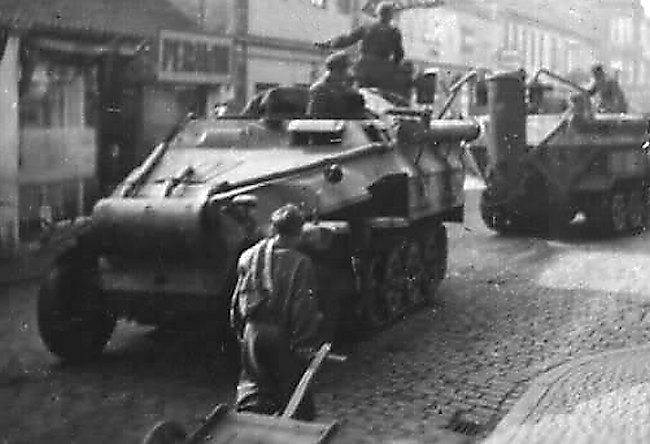
Two Sd.Kfz.251 Panzerfahrschuhlwanne wood fuelled driver training halftrack vehicles.
Links about the Sd.Kfz.251
Lots of information about the Hanomag
Wikipedia page about the Hanomag
The Ausf.D on Achtung Panzer
Sd.Kfz.251/1 specifications |
|
| Dimensions | 5.80 x 2.10 x 1.75 m (19×6.10×5.9ft) |
| Total weight, battle ready | 7.81 tons |
| Crew | 2 (commander, driver) +10 Panzergrenadiers |
| Propulsion | Maybach HL42 6-cyl, 100 hp, 12 hp/t |
| Suspension | Half-track torsion arms, interleaved wheels |
| Maximum speed | 53 km/h (33 mph) |
| Range | 300 km (186 miles) |
| Armament | 2 x Rheinmetall MG 34/MG 42 machine guns |
| Armor | From 6 to 14 mm (0.24-0.55 in) |
| Total production | 15,252 |
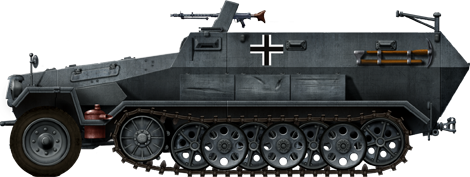
Sd.Kfz.251/1 Ausf.A, 1st Panzerdivision, Poland, September 1939. It has the regular armament most Panzergrenadier’s Hanomags would bear during the conflict: a frontal MG 34 protected by a mask for infantry support, and a rear AA mount with greater traverse and angle.
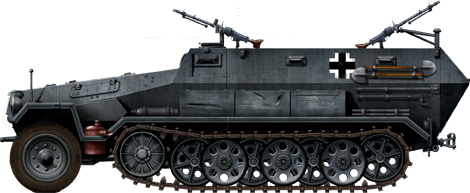
Sd.Kfz.251/1 Ausf.A, 1st Panzerdivision, French campaign, May 1940, armed with two AA pintle mounts.
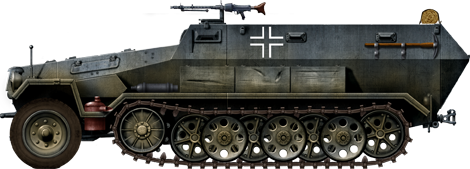
Sd.Kfz.251/1 Ausf.A, 1st Panzerdivision, Russia, July 1941. Notice that the rear pintle mount was removed in order to make place for a tarpaulin.

Sd.Kfz.251 Ausf.B with two MG shields in Greece, April 1941.
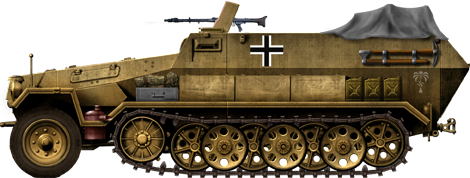
Sd.Kfz.251 Ausf.B of the Deutsche Afrika Korps, 21st Panzerdivision, Libya, March 1941.
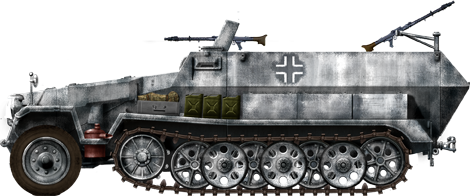
Sd.Kfz.251/1 Ausf.C – 12th Panzerdivision, Russia, Moscow sector, winter 1941/42.
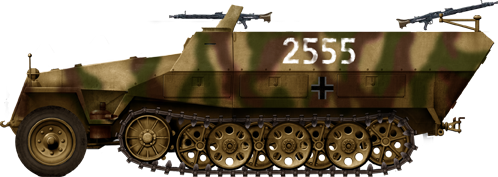
Sd.Kfz.251/1 Ausf.D in Russia, summer 1942.

Sd.Kfz.251/1 Ausf.D in Tunisia, February 1943.
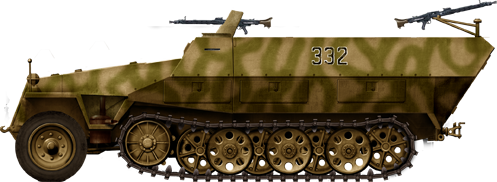
Sd.Kfz.251/1 Ausf.D, IIIrd Gepanzert Battalion, SS Panzergrenadier Regiment 9 “Germania”, part of the 5th SS Panzerdivision “Wiking”, Modlin sector, Poland, August 1944.
Sub-versions
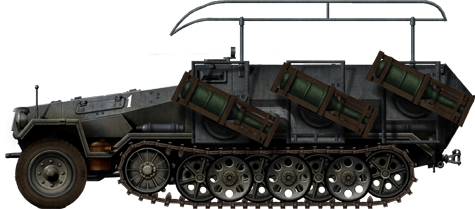
Sd.Kfz.251/1 II Ausf.B Mittlerer Schützenpanzerwagen mit Wurfrahmen, the famous “Stuka zu Fuß” or “Stuka on foot”, 7th Panzerdivision, Russia, November 1941.
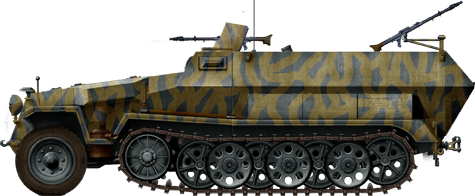
Sd.Kfz.251/2 Ausf.C Schützenpanzerwagen (Granatwerfer), 81mm mortar carrier, Russia, early 1942.
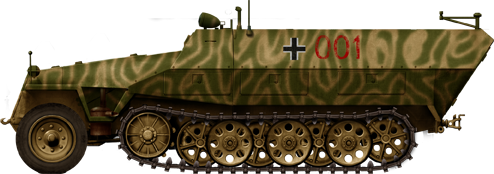
A Sd.Kfz.251/3 II Ausf.D Mittlere Kommandopanzerwagen Ausf.D, meant for liaison with tanks formations, Normandy, France, summer 1944.
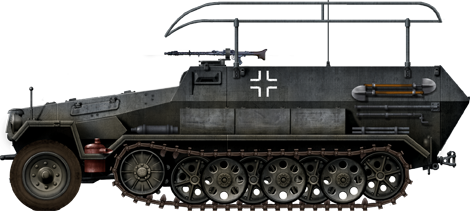
Sd.Kfz.251/6 Ausf.B mittlere Funkpanzerwagen (Kommandopanzerwagen), the personal vehicle of General Guderian, France, June 1940.
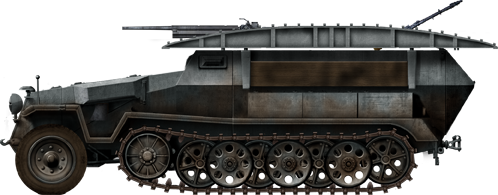
Sd.Kfz.251/7 II Ausf.C Pionerpanzerwagen, Russia, 1942. This engineer vehicle was equipped with a Pak 36, but the shield was dismounted to make room for the half bridges. Additional planks were also usually carried.
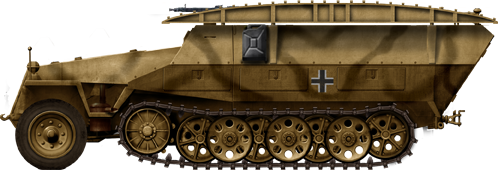
Sd.Kfz.251/7 I Ausf.D Pionerpanzerwagen, Tunisia, January 1943.
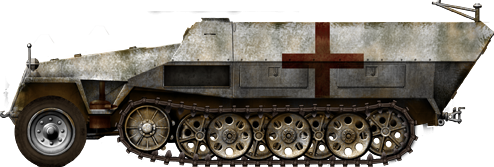
Sd.Kfz.251/8 I Ausf.D Krankenpanzerwagen, Stalingrad, December 1942.
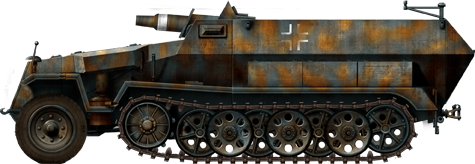
Sd.Kfz.251/9 Ausf.C Stummel – 12th Panzerdivision, Russia, summer 1942.
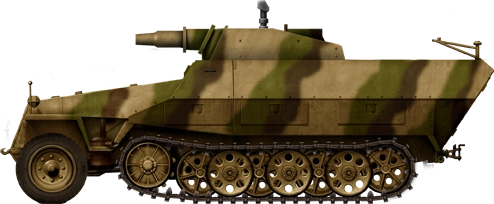
Sd.Kfz.251/9 Ausf.D (Model 1944) Stummel, battle of Rimini, Gothic line, northern Italy, December 1944.
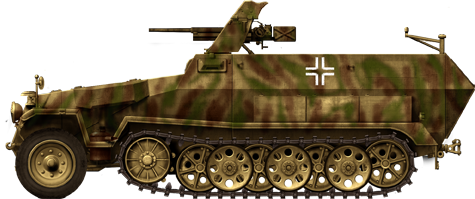
Sd.Kfz.251/10 Ausf.C – 5th Panzerdivision, Gustav line, Italy 1944.
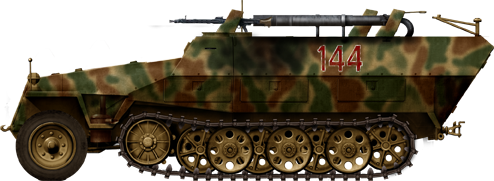
Sd.Kfz.251/16 Ausf.D Flammpanzerwagen, Normandy, summer 1944.

Sd.Kfz.251/17 Ausf.C Schützenpanzerwagen (2cm) (Flakpanzerwagen 38), Russia, 1943. This AA vehicle was armed with the FlaK 38 20 mm (0.79 in) autocannon on a pedestal mount, protected by a large curved shield, and the hull accommodated folding panels to allow more traverse.
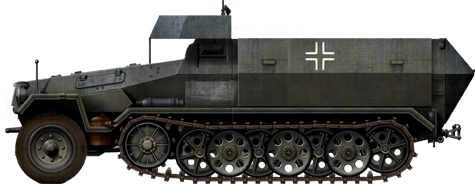
An up-armored Sd.Kfz.251/18 Ausf.B Beobachtungspanzerwagen, Russia, 1942.
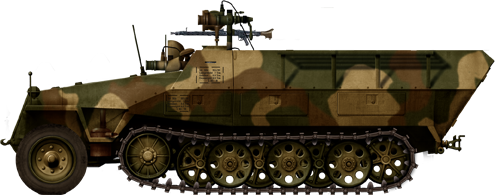
Sd.Kfz.251/20 Ausf.D mittlere Schützenpanzerwagen zur Gefechtsfeld-beleuchtung (Falke), Western germany/, January 1945. This vehicle worked in close coordination with the “UHU” version.
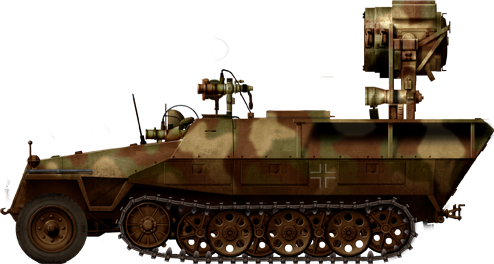
Sd.Kfz.251/20 Ausf.D mittlere Schützenpanzerwagen zur Gefechtsfeld-beleuchtung (UHU), long-range infrared illumination version operating with the Panzer V Panthers during night attacks, Western Front, 1944-45. It consists of a 60 cm Beobachtungstelescope (telescopic sight) 1221 and a Beobachtungsgerat (viewing machine) 1251. Around 60 UHU were built to assist “Sperber” formations of six Panthers each. Some were also deployed in Hungary in 1945.
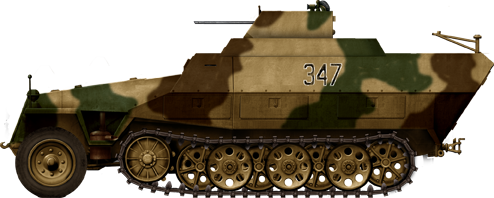
Sd.Kfz.251/21 Ausf.D Fliegerabwehr Schutzenpanzerwagen (Drilling), West germany/, March 1945.
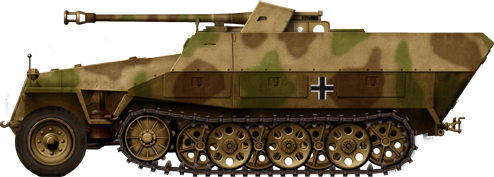
Sd.Kfz.251/22 7,5cm PaK 40 L/46 auf Mittlerer Schützenpanzerwagen Ausf.D, Caen sector, Normandy, France, June 1944.
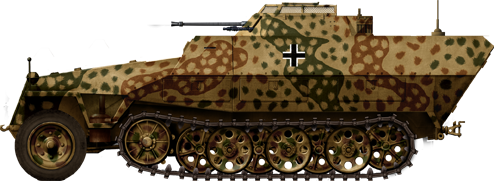
Sd.Kfz.251/23 Ausf.D mittlerer gepanzerter Schützenpanzerwagen mit 2cm Hängelafette, Western germany/, January 1945.
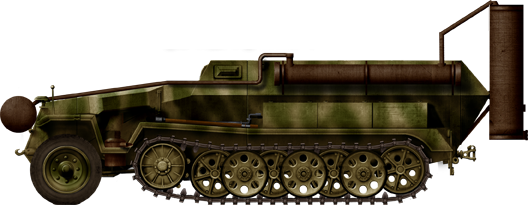
Sd.Kfz.251 Wood fuelled Panzerfahrschuhlwanne driver training vehicle.
Gallery

WW2 Tanks




























WW2 tanks posters

All Tiger tanks liveries.

Panther liveries and variants

WW2 Armour - All tanks











Tanks aces and single tanks series

Find more there

Museums, Movies, Books & Games
The Tanks and Armor in pop culture
Tanks and armored vehicles in general are only really grasped when seen first person: The mass, the scale, it's all there. Explore also the way tanks were covered in the movie industry, in books and in video games.Movies:
Best tanks movie on warhistoryonline.com
On imdb.com
On bestsimilar.com/
miltours.com
liveabout.com/
watchmojo.com
Video Games:
pcgamesn.com
historyhit.com
levvvel.com
vg247.com/best-tank-games
mmobomb.com/
alienwarearena.com


